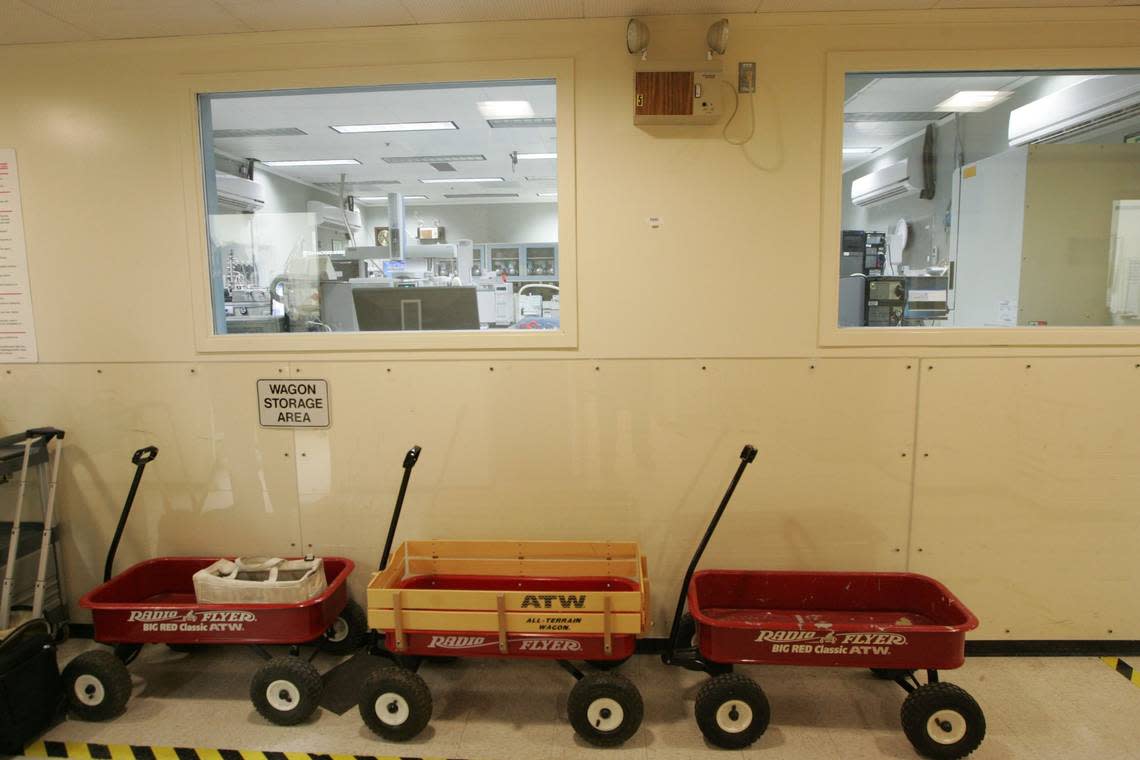What’s known about the evacuation and need for a bomb squad at Hanford last month?
The Department of Energy contractor for the 222-S Laboratory at the Hanford nuclear reservation is evaluating its handling of chemical wastes after the Richland bomb squad was called to the lab in February.
A small amount of the chemical crotonaldehyde was being prepared for disposal off the Hanford site on Feb. 20, according to a recently released weekly report prepared by the Defense Nuclear Facilities Safety Board staff.
When packaging was opened, an employee noticed what appeared to be crystals that had formed on a vial, which held about a thimble-full of the chemical, the Department of Energy said last month.
When crotonaldehyde is exposed to air it forms peroxides, which can have explosive properties. DOE called the chemical potentially “extremely dangerous” when crystals form.
The worker who opened the packaging immediately stopped work and notified management.
Work was stopped first in one room of the lab and then nearby rooms were cleared.
The Hanford Emergency Operations Center and Hanford Fire Department were called, with the fire department determining that the safest action would be calling the Richland Police Department bomb squad to take the chemical off Hanford.
Before the bomb squad removed the chemical, the facility was evacuated, according to the DNFSB report. About 50 to 60 people were in the lab.
Richland police destroyed the chemical at the police department’s field range.
“The worker’s swift action and the contractor’s decision to contact the Emergency Operations Center for immediate removal was the right approach to this abnormal condition,” said Paul Schroder, Hanford DOE deputy assistant manager for tank waste operations, earlier this month. “Safety is always the priority, as it was in this situation.”
Investigation of chemical event
The laboratory contractor — Hanford Laboratory Management and Integration owned by Navarro Research and Engineering and Advanced Technologies and Laboratories International (Navarro-ATL) — held an event investigation meeting in February to discuss the incident, according to the DNFSB report.
At the meeting it was determined that the manufacturer’s storage requirements were not maintained after the chemical was declared waste, and its complete storage history was not known, according to the DNFSB report.
In addition, the process for inspecting chemicals based on quantity and not requiring periodic inspection of chemical waste also was questioned.
DOE said that Navarro-ATL has been stabilizing and transporting aged chemicals to offsite treatment, storage and disposal facilities since the start of its contract in 2021. The contractor expects all aged chemicals to be offsite by the end of this year.
“The safe analysis of high level (radioactive) waste samples is the priority of our operation at the 222-S Lab to support resk reduction in the cleanup mission,” said Rober Schroeder, analytical operations director for Navarro-ATL.
“We balance the workload to maintain that priority against the need to address the backlog of chemicals leftover from years of past laboratory operation,” he said.
The 222-S Laboratory is used to analyze highly radioactive waste samples, primarily waste stored in underground tanks from the past chemical processing of irradiated uranium to remove plutonium for the nation’s nuclear weapons program.

The 580-square-mile Hanford nuclear reservation site adjacent to Richland was used from World War II through the Cold War to produce nearly two-thirds of the plutonium for the nation’s nuclear weapons program.
At the heart of the 222-S Laboratory complex is a 70,000-square-foot building with more than 100 pieces of analytical equipment, 156 fume hoods, 46 remote manipulators and 11 hot cells where workers operate handling equipment from outside the cells and look through thick, leaded glass to work with radioactive waste samples within the hot cells.
The complex also has several support buildings.
